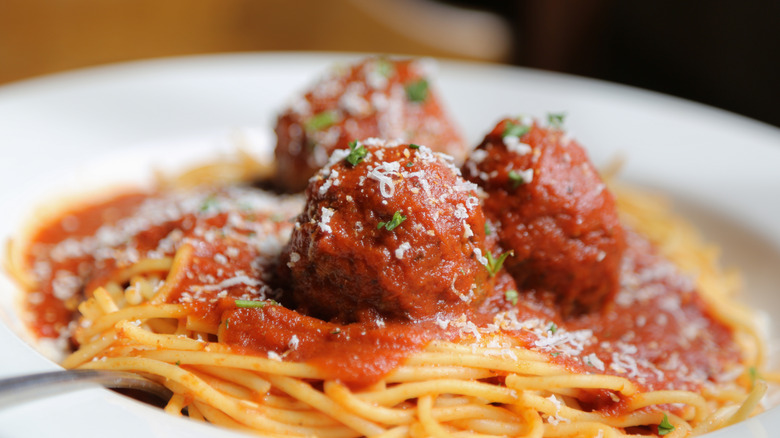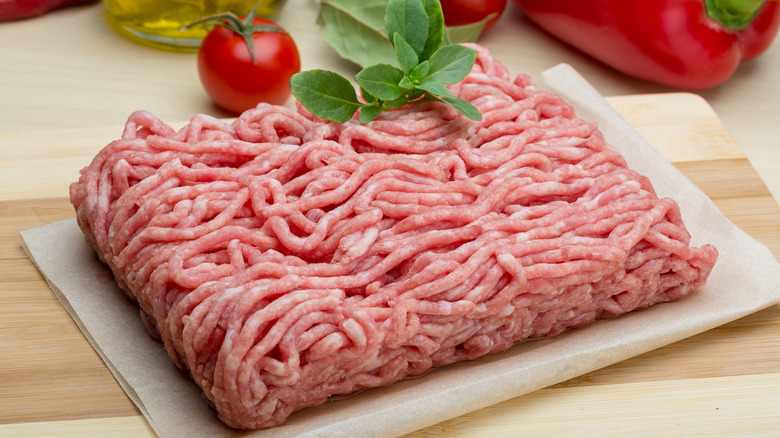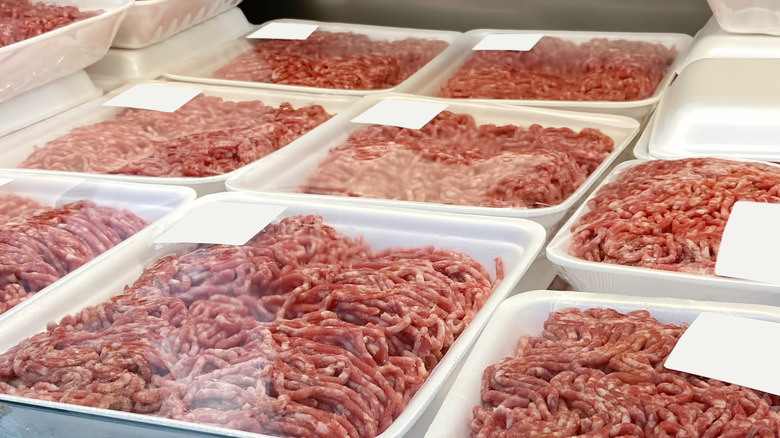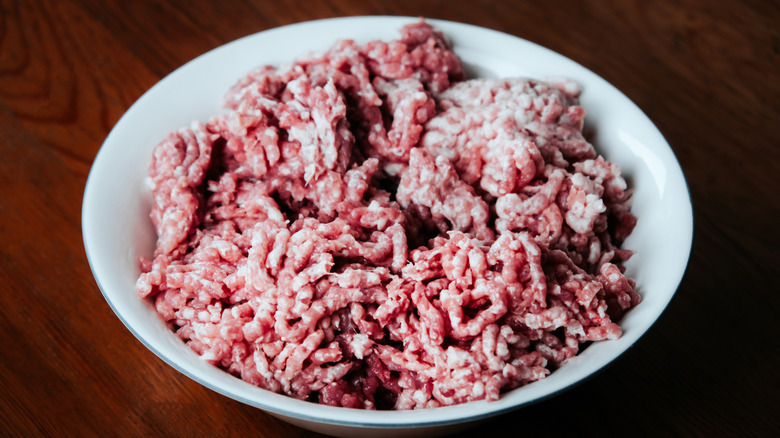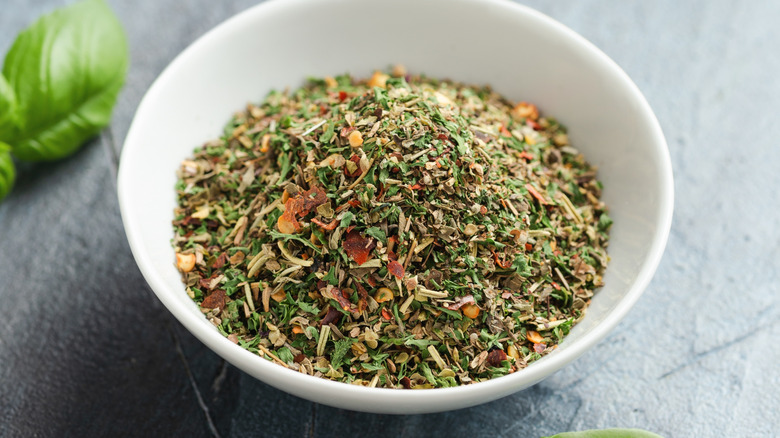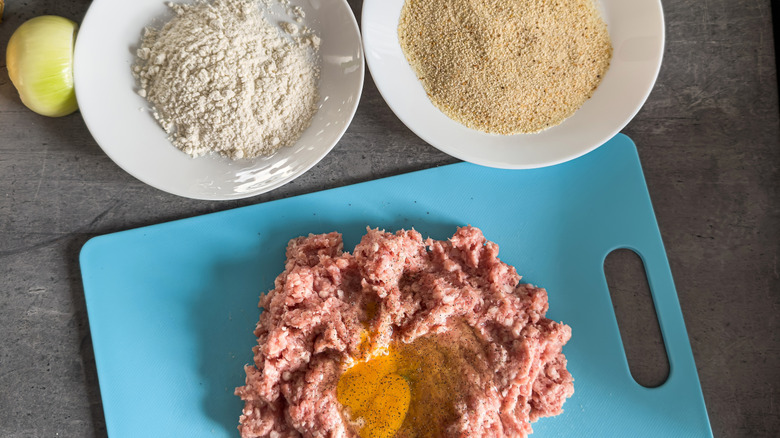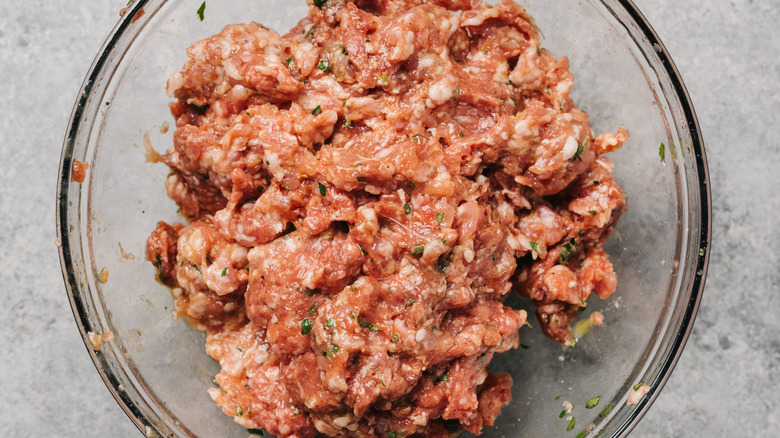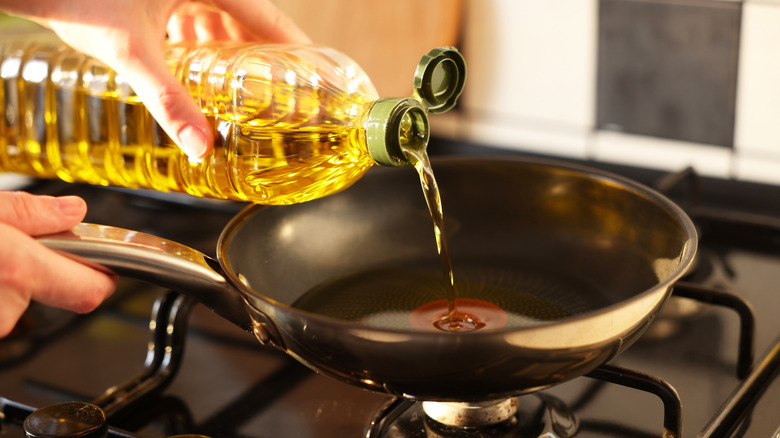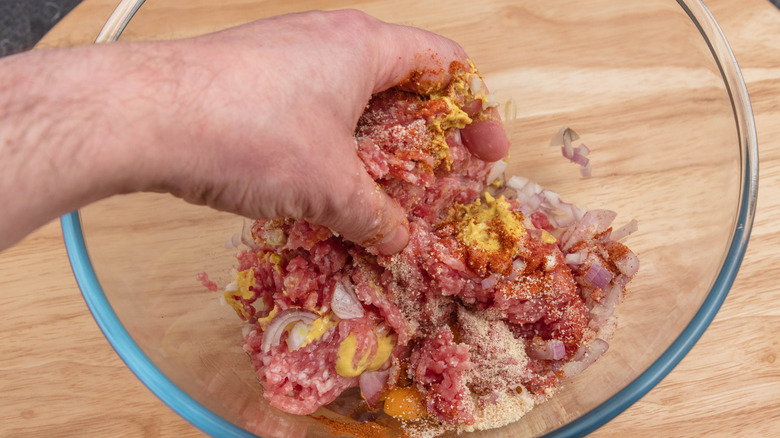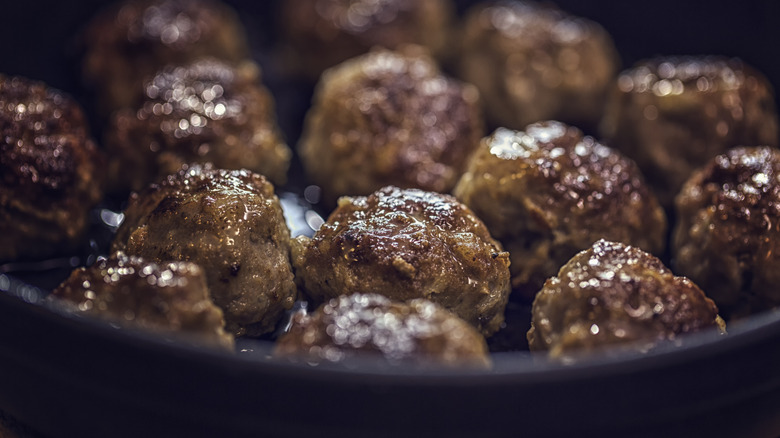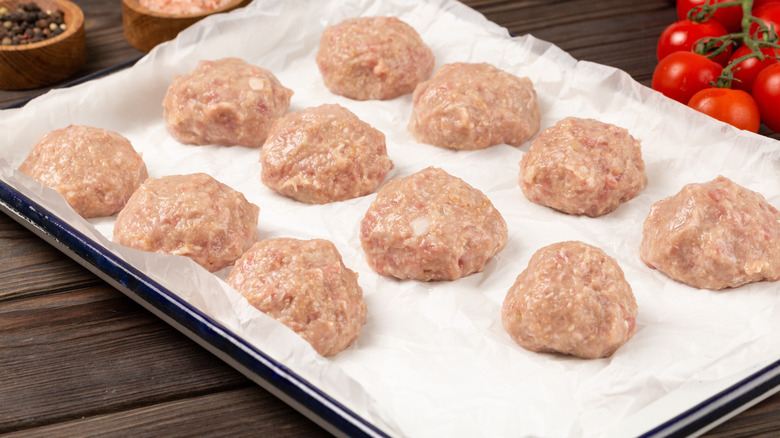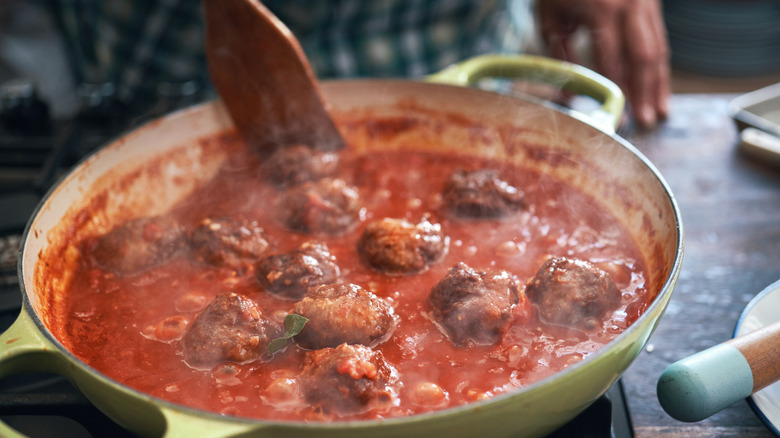Common Mistakes Everyone Makes When Cooking Meatballs
There are so many delicious possibilities when cooking meatballs from scratch. Toss them in velvety red sauce and pasta for a delightful Sunday dinner or poke them with toothpicks to serve at your next book club meeting. And don't forget about the global interpretations, from Scandinavian spheres to delectable Persian Kofta, that cosign their versatility.
But if you've struggled to make meatballs as good as your favorite restaurants, some sneaky little errors could be hampering your efforts. Meatballs should be juicy and plump, offering a little give when you bite or slice them in half. The squishy softness from the breadcrumb binder and hints of spice mingling within every tender morsel can be hard to master like a pro.
Exploring the most common meatball mistakes required getting the 411 from highly trained experts. Bryan Forgione, a chef at Buddy V's Ristorante at The Venetian Resort in Las Vegas, and Rosangela Teodoro of the Boston-area butcher shop Teodora's Boucherie Gourmande, divulged some of their tips to turn dense, chewy meatballs into marvelous show-stoppers. Whether it's learning how to select quality meat or stamping out blah-ness with good spices, allow this guide to elevate your culinary game. These are 12 common mistakes that keep you from making the tastiest meatballs around.
Using lean meat
Despite the health benefits of leaner protein, they don't offer a lot in the way of fat. Fat is a core element of successful meatballs; not only does it help the ingredients stick together, but it assists with lending a tender and juicy texture. Not selecting high-fat meat is an error that's famously connected to dry, boring meatloaf — and by extension, dry, boring meatballs, too.
It's a matter of fact that beef and pork will possess higher amounts of fat, so when shopping at the supermarket, keep your eye on the label. Bryan Forgione recommends portions that list an 80/20 divide, which translates to an ideal consistency of 80% leanness to 20% fat. Options could fall into the camp of a ground chuck, sirloin, or perhaps fatty minced pork.
Generally, avoiding poultry is wise when the sole priority is achieving a fork-tender morsel, but as Forgione told Chowhound, the choice is doable — simply ensure that your filler is wet enough so that it can hydrate the protein properly. An "incredible" recipe his wife swears by features chopped-up zucchini with turkey boasting 93% lean meat and 7% fat.
Purchasing your meats pre-ground
Maybe this next faux pas seems surprising, even bougie, to the average cook at home. What else would you purchase to make meatballs other than pre-ground meat? Yet there is a problem with the selection at most supermarkets, and perhaps it explains why your meatballs might turn out chewy for the umpteenth time. Pre-ground meat tends to be minced at a single setting, creating a consistency that's mealier and prone to growing firm from rigorous handling.
Like any professional meat merchant, Rosangela Teodoro understands the proper grind can make or break any carnivore-centric dish. It isn't surprising, then, to see why many meatball experts opt to get their cuts freshly ground instead. As a general rule, meat that's prepared to order will be customized to fit your cooking needs, letting you be in control of everything from the variety you want down to the quantity and desired texture.
If you're unsure of what to ask for, a professional butcher — whether at a specialty market or your local grocery store — is capable of assisting you every step of the way. "Inform your butcher about your recipe so they can make meat and grinding recommendations," says Teodoro. True, grabbing raw hamburger meat right off the shelf is convenient in a time crunch. But it's not always the answer to a mouthwatering meatball experience.
Only opting for one kind of meat
When skimming the menu of any knock-out Italian joint, typically you'll notice that the restaurant never rolls out meatballs with only beef or only pork. Why is that? As opposed to a single type of meat, utilizing a blend for your meatball mixture improves the dish on multiple counts. For one, variety helps to enhance the flavor profile, whereas the act of crafting a combination inspires a far more sensational mouthfeel and finish. Without this diversity of fat and meatiness, your meatballs will likely taste a little one-note.
Although this can easily go over budget, expanding your blend is worth the splurge if it means your dinner — even occasionally — rivals a marvelous red sauce spot. At the Sin City establishment where Brian Forgione is based, the Grandma's Meatballs appetizer touts the triple-threat of authentic Italian-American eateries: pork, beef, and veal. But the wide array of cuisines out there doesn't have to limit you to trattoria fare exclusively. Rosangela Teodoro vouches for molding your balls out of lamb and beef if Mediterranean flavors are more your jam, whereas a red meat blend would be ideal for attempting a certain furniture retailer's Swedish-style meatballs.
Not using enough seasoning
Your meatballs could be plated on a gorgeous bed of spaghetti in oodles of marinara, but if they're not seasoned properly, then was there any point in rolling up your sleeves to make them the old-fashioned way? On average, meatballs contain a heavy dose of flavor thanks to spices, and including them generously is crucial in distinguishing a ho-hum batch from a fantastic one. Underestimating the amount you mix into your meat will only lead to blandness, a misfire no sauce will be capable of masking. You might as well throw in the towel and make a hamburger because, without a hearty amount of spices, you won't be making a meatball.
This is why novice cooks should follow the golden rule for all cooking concerns, which is seasoning every step of the way. The meat is a blank canvas, so toss in the classics — think salt, pepper, and basic cooking herbs — and plenty of them. Fresh garlic or parsley are excellent sources of aromatics, while shredded Italian cheeses such as Parmesan can benefit your meatballs by upping the saltiness a notch.
Professional butcher Rosangela Teodoro also approves of onions, both to aid hydration and as a booster for savory, umami undertones. Some seasonings can be overdone though, so keep your recipe in mind. Overall, adding a teaspoon of salt per every pound of meat is a good rule of thumb.
Making your filler too dry
The quality of your meat and seasonings can impact these bite-sized balls, but equally significant to the culinary equation is a moist binder. Binders function as an economical workaround to stretching out your (comparatively expensive) source of protein. According to Rosangela Teodoro, "good breadcrumbs with milk" remains the classic formula. But don't forget what the mixture is for. It's an adhesive, and it's intended to retain the shape of your meatballs while simultaneously keeping them pillowy and plush. If your meatballs instantly crumble apart or leave behind a starchy aftertaste, it could be a sign that your filler is dry.
The culprit for dry binding tends to be an excess of breadcrumbs. If there isn't enough liquid for them to soak up, the bread-y bits will end up leaching the beefy, porky juices instead. Likewise with eggs, since their role is primarily for structure, not for tenderizing the meat.
To fix your binder, double-check that it contains plenty of liquid. Dairy, like buttermilk or whole milk, is preferred due to its high fat content. Some chefs bathe the breadcrumbs in milk to make what is called a panade (this is how Gordon Ramsay develops top-tier meatballs) or cube up stale bread, waterlogging the chunks into a soggy sludge.
The ratio of binder-to-meat is off
On the topic of filler, here's another thing to keep in mind when putting together the starchy glue: are the ratios equal? Regardless of the recipe you're working with, a core component of a delicious meatball must be ensuring your binder and protein are measured correctly and proportionately to each other. Otherwise, neither element will truly meld when incorporated, and that'll only spell out trouble and throw the success of your home-cooked meal into the balance.
In Bryan Forgione's experience, "not having enough fat or too little binder" is largely to blame for meatballs coming out dry and lackluster — the polar opposite of the supple disposition that differentiates meatballs from a similar family member, the burger. When your ingredients are level and blended to a T, the mix is going to be homogenous in tone, smooth, and unmarked by rogue lumps of panade.
Run through your recipe to check the measurements. Remember, depending on the amount you churn out, the ratios might need to be tweaked, but a basic formula is, for every single pound of protein, use at least one egg and 1/4 cup of breadcrumbs.
Not cooking a tester
Sampling a dish in progress is when it's easiest to tinker with any elements that might need adjustments. However, you can really only do this when the entree is nearly ready-to-eat, like a slow-cooker chili or soup. Meatballs start out raw, however, and can only be consumed safely once they're fully cooked. If you forget to crack that extra egg in your panade, or leave out the pepper flakes, your batch won't be salvageable by the time you've loaded the meatballs into the oven or your skillet.
So how can you avoid this potential heartache, knowing how long it can take to make meatballs from scratch? Start by cooking a tester beforehand. This is a preventative measure even the most accomplished chefs never neglect, and it only requires a couple extra minutes of your cooking time. All you have to do is grab a small lump of your mixture and sear it in the pan to taste. This way, you can double-check that your base is adequately seasoned and fit in last-minute tweaks before balling the rest of the meat up. Buddy V's Bryan Forgione is a huge proponent of this precautionary step, since it eliminates the hassle of dealing with a disappointing batch, saving time in the long run.
Handling the meat mixture roughly
Assuming it doesn't gross you out, wading through the squishy pink goo is definitely a fun part of doing meatballs at home. But to perfect their deliciousness, professionals abstain from employing a heavy hand during mixing, and for good reason. "Over-mixing can give you springy meatballs that will have more of a sausage-like texture," says Bryan Forgione. Likewise, your meatball mix can grow tough from heat, due to the direct contact of your hands toughening up the fat and fiber strands coursing through your meat.
On textural matters, it's best to knead and massage the mish-mash with a light touch, resisting the temptation of squelching the concoction between your fingers. Tumble everything together until the spices and starches are dispersed evenly — then stop.
Some chefs even avoid getting their hands dirty in the first place. One hack to mix together the blend in a pinch is to use a piece of silverware as your mixing apparatus. A fork from your utensil drawer works wonders in tossing the mixture around seamlessly, without pressurizing your base into a paste-like substance.
Failing to brown the outsides for maximum flavor
In your quest to master the meatball, don't overlook the power of perfectly browned meat. Getting the outsides golden and crispy packs in a lot of extra flavor, and while browning happens to affect their spherical tendencies, the payoff is a taste and texture that's much bolder on the palate.This process is known as unlocking the Maillard reaction, and the series of chemical responses embed your protein with a glorious broiled coating.
Contrastly, poaching meatballs in your sauce is a convenient way to minimize your labor in the kitchen, and results in a lovely sumptuousness. Should mouthfeel be a dealbreaker however, this method will not lead to any charring or the craggy edges as it's cooked.
One tip Bryan Forgione gave Chowhound essentially provides the best of both these worlds, in terms of gaining both color and tenderness. It begins by sauteeing the meatballs on the stove ("in a good amount of olive oil," Forgione emphasizes), followed by transferring them to whatever sauce you're making. The idea here is the meatballs develop crusting from roasting in the pan, while simmering them in the pot reinforces the meatier sensibilities.
The meatballs aren't equally sized
On your tray, you might find some meatballs that are raw and under-baked while others are burnt and shriveled. This happens because your meatballs are not consistently sized. Forming your meatballs by hand grants you a license to make them whatever size you want. But if you roll them willy-nilly and neglect portioning them into equal pieces, they're not going to finish cooking at the same time. This issue is especially pronounced should you favor baking them all in one go in the oven.
Much like the task of putting together your meatball mix, this step, once again, doesn't have to involve your hands if you don't want it to. To prevent a potential kitchen nightmare, there are plenty of tools you can take advantage of for identical (and aesthetically pleasing) meatballs. The most common device acclaimed cooks reach for are ice cream scoops, being that the device creates uniform spheres in a pinch. Certain types of scoopers feature a nifty press-down handle — just dip it into the mix, click, and release until you're left with beautiful, round rows.
Not chilling the meatballs prior to cooking
One of the biggest problems meatball-making entails? Finding they don't keep their shape. One explanation for this dilemma is you're dropping your raw orbs on the baking sheet or the stovetop to immediately start the process of searing them. Raw meat is quite sticky, especially at room temperature, lacking the composition to withstand the heat of a blazing-hot surface. Do not cook your meatballs until they've chilled in your refrigerator. Much like cookie dough, chilling is beneficial in solidifying a wet mixture. Your meatballs will encounter much more resistance to breaking down when they've sat for a spell in the cold.
Unsure just how much time your meatballs need to chill out? A brief lull is totally acceptable — at least 10 minutes will suffice but you can extend the wait to 20 minutes if you'd like. Take advantage of the break to accomplish other tasks associated with your meal, since once they've firmed up, it'll be smooth sailing to dinnertime. This method is also key to gaining the rounder shape normally lost to pan-frying.
Leaving the meatballs simmering too long in sauce
It's tempting to imitate an Italian mafia flick and leave your meatballs on the stove, simmering indefinitely in a bubbly sauce. But for preserving the structural integrity of your orbs, a lengthy soak seems to only bring downsides to the table. Endless hours boiling in a pot can cause your meatballs to overcook, getting chewy instead of appealingly plush. So take Chef Bryan Forgione's advice and resist letting them linger extensively in the marinara. The less time they spend simmering, the less opportunity there'll be to harden up.
If you're wondering what the right moment would be to add your meatballs, it's basically when they're a hair's breadth away from being done. USDA guidelines suggest checking for an internal temperature of 160 degrees Fahrenheit to be considered safe to eat, so have a meat thermometer handy.
The primary motivation driving this tactic is to enrich the sauce with a beefier feel. A workaround to infuse the sauce without disturbing the main attraction is to sear a tiny chunk of meat in the skillet and allow the fat and juices to render out. The grease and oil can then coat the remainder of your aromatics and spices, forming the base for your sauce to take shape.
